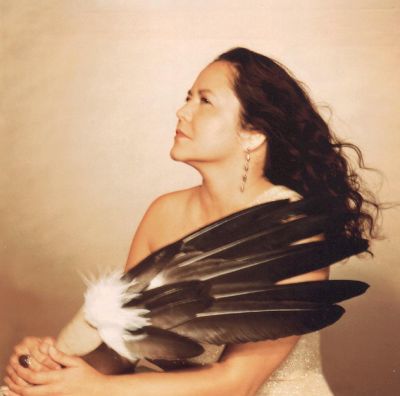Altri Sud
IDENTITÀ E PACE / Intervista con la cantautrice nativa americana Joanne Shenandoah

Preservare l’identità culturale significa a volte salvare una possibilità di pace universale. Difendere la diversità significa salvare il mondo.
Questa storia comincia un pomeriggio con una ricerca su internet, con due semplici parole chiave: Iroquois music (musica irochese); con il desiderio di essere trasportata via per qualche minuto al di là dell’oceano, in un’utopia vivente. Così ho scoperto la cantante e cantautrice nativa americana Joanne Shenandoah. Lei è un’irochese della nazione Oneida, membro del Clan del Lupo, che si trova nello Stato di New York. La sua musica attinge alla ricca tradizione culturale irochese, rendendola un messaggio universale di pace; molte delle sue canzoni sono scritte in lingua Oneida. Ha cantato in Italia al Vaticano, per la canonizzazione di Santa Tekakwitha, la prima santa nativa americana. Joanne Shenandoah è anche portavoce per la pace, per i diritti delle donne e dei bambini, e una dei fondatori dello Hiawatha Institute for Indigenous Culture.
Il tipo di società da cui lei proviene è per noi molto speciale, come si comprende dalla sua musica e dai titoli dei suoi album. Ho avuto il piacere di intervistarla, come esempio di saggezza, creatività e dedizione per il bene della comunità.
L’album The Peacemaker’s Journey (Il viaggio del pacificatore), prima nomina ai Grammy Awards per Joanne Shenandoah, è ispirato alla storia della fondazione della Confederazione irochese.
“Erano tempi bui, tempi di guerra.” racconta “quando il Pacificatore viaggiò di comunità in comunità, diffondendo la good mind (lett.: buona mente) e insegnando le leggi della pace. I primi a seguirlo furono Hiawatha e Jigonhsasee, la prima Madre del Clan. Alla fine, attraverso la musica e il canto, i popoli riuscirono a perdonare, e decisero di vivere in un mondo senza guerra.”
La Madre del Clan è una delle figure più importanti della società irochese, che è matriarcale:
“Significa che le donne, le Madri dei Clan, scelgono i Capi, e sono responsabili del benessere politico, sociale e spirituale del popolo. Mia madre era una Madre del Clan, e mio padre era un Capo.”
Joanne Shenandoah ha dedicato un intero album, chiamato Matriarch, alle donne irochesi. Con le sue delicate e affascinanti melodie, la sua musica è un’esperienza spirituale di rigenerazione.
Nell’album Eagle Cries c’è una bellissima canzone, chiamata Dancing on Mother Earth (Danzando sulla Madre Terra). “La Madre Terra è dove viviamo, è il nostro pianeta, che ci nutre, ci sostiene. Tutto ciò che viene da lei ci dà vita. Lei è la nostra madre, viviamo in lei proprio come viviamo nel grembo di nostra madre. Lei è l’acqua, gli alberi, le piante, le erbe medicinali, è tutti i frutti e le verdure.” ci racconta, in una videochat da cui scaturisce questa chiacchierata.
Penso che il tuo racconto sulla vostra cultura e sui vostri valori sia una testimonianza preziosa per noi, perché non ci viene detto spesso di questi aspetti fondamentali della cultura nativa americana.
Penso che molte persone nel mondo non sappiano da dove viene la democrazia. Noi avevamo uno straordinario senso della libertà e della giustizia. Avevamo la possibilità di esprimere le nostre opinioni, a prescindere da chi fossimo. Non c’era alcun sistema di classi o di caste nella nostra società. Perciò è molto difficile per noi comprendere il fatto che solo certe persone possano votare, solo alcune persone possano dire la loro sui cambiamenti, sulla giustizia sociale, al governo.
Una società così sembra per noi qualcosa che non può esistere, poiché viviamo oggi gli effetti di un modo di vivere molto violento e iniquo. Ci viene spesso detto che un sistema sociale diverso, uno come il vostro, può esistere soltanto in un’utopia. Come fate a sopravvivere come popolo in un mondo così?
Lottiamo continuamente per preservare la nostra cultura e la nostra identità, attraverso le cerimonie, e attraverso il canto, continuando a celebrare i nostri riti spirituali. Il mio compito è di dar vita a canzoni, ed è quello che ho fatto con i miei 23 album. Faccio ciò che è mio dovere fare, come il sole e la luna nel cielo; così come ogni persona ha il diritto e la responsabilità di esprimere il bene nel proprio cuore e nella propria anima, per le future generazioni. Cerchiamo di istruire e al contempo di imparare gli uni dagli altri: e questo è molto importante. Molti popoli hanno la loro religione, riguardo alla quale dicono: “Questa è quella giusta. Questo è l’unico modo di fare le cose.” Noi accogliamo tutte le culture e le spiritualità nella forma del nostro pensiero, che è la good mind.
Che cosa vuol dire per una donna vivere in una società matriarcale?
È naturale! È un processo naturale. Tutte le donne vogliono che i propri figli vivano in un ambiente meraviglioso, che sia dolce, naturale, pulito. Vogliamo che i nostri figli mangino bene e possano bere e lavarsi in acqua pulita. Vogliamo che siano sani, che vivano vite lunghe e belle.
Sei anche una portavoce la pace per i diritti delle donne e dei bambini. Puoi dirci qualcosa sulla tua attività in questo campo?
Ho passato un anno con l’attorney general degli USA (un alto funzionario, la cui funzione principale è fornire consulenza giuridica al governo), visitando tutte le riserve e i territori nativi americani. Ho ascoltato testimonianze sulle esperienze traumatiche che molti della nostra gente hanno sofferto, che sono filtrate attraverso le generazioni. Anche se si tratta di una violenza passata, ci colpisce ancora. L’anno che ho passato con l’attorney general, andando di riserva in riserva, è stato molto difficile per me, perché ho esperito l’intensità della violenza a cui i bambini erano esposti; ho capito che così tanti bambini erano in grandi difficoltà. Abbiamo scoperto che non solo i bambini nativi americani, ma anche i bambini di tutta l’America soffrivano gli effetti della guerra e della violenza, che fosse domestica o internazionale. La violenza è ovunque intorno a noi, e ne siamo tutti toccati: è nei videogiochi, nelle nostre case, nelle strade, nei telegiornali. E ci influenza in molti modi: attraverso lo stress, la cattiva salute, nel modo in cui ci comportiamo, e anche nel modo in cui pensiamo alla famiglia e alla comunità.
L’anno che hai trascorso con l’attorney general mi fa pensare al messaggio in uno dei tuoi album, The Peacemaker’s journey.
Contrasta profondamente con la nostra cultura il tirarsi indietro davanti ad atti di violenza o di guerra, senza impegnarsi in uno sforzo collettivo per la pace. Per esempio, gli Irochesi usavano un gioco chiamato Lacrosse, per appianare le controversie, come alternativa alla guerra. Non si trattava di uccidere persone: lo scopo del Lacrosse era di calmare le energie delle persone, per poter prendere decisioni che fossero il meglio per tutti.
Il messaggio fondamentale dell’album è che possiamo vivere in un mondo senza guerra. E possiamo fare uno sforzo collettivo per mettere insieme le nostre menti, con good mind, e prendere decisioni per le future generazioni.
Dunque la vostra cultura trasmette pace e rispetto per il pianeta.
Sì, per me è molto difficile pensare che siamo separati dalla Terra, perché è lei che ci nutre e sostiene. Per esempio, non ha alcun senso per me sperimentare mutazioni genetiche su frutti e verdure, allo scopo di liberarsi dei semi. Noi vogliamo che i nostri figli, i nostri nipoti, e i loro figli continuino a godere dei frutti che la Madre Terra ci dona.
Molte delle tue canzoni sono scritte in lingua Oneida. La lingua è parlata ancora nella vostra comunità?
Sì, la lingua è molto vitale oggi, e si sta trasmettendo soprattutto attraverso i giovani e i bambini. Ci sono stati tempi brutti per la nostra lingua, e per la nostra cultura in generale, quando i nostri bambini venivano mandati nei collegi, dove gli veniva imposto di tagliarsi i capelli e venivano puniti se parlavano la lingua nativa. Ma adesso c’è una rinascita: i nostri giovani celebrano le cerimonie e parlano la lingua. Gli irochesi parlano molte lingue diverse, ma riusciamo a capirci tra noi. Mio nonno parlava tutte e sei le lingue degli Irochesi.
Puoi dirci qualcosa sulla tua attività corrente?
Ho pubblicato di recente un audiolibro in tre Cd, A Narrative of the Life of Mrs. Mary Jemison, Un racconto della vita di Mrs. Mary Jemison, che racconta la storia di una bambina irlandese, che fu adottata dalla nazione Seneca, una delle nazioni irochesi. Ho scritto la musica per un documentario su Wilma Mankiller, la prima donna Capo principale della Nazione Cherokee dell’Oklahoma. Sto anche lavorando alla musica, naturalmente: sarà trasmesso sulla tv nazionale (PBS) uno show con Robbie Robertson (The Band).
Che cosa significa l’immagine che ci hai inviato per l’articolo?
Il disegno è di Marcia K. Moore, rappresenta me legata alla Terra e ispirata dai nostri antenati, che, come noi crediamo, si trasformano in stelle e tornano al mondo del cielo. Sarà la copertina del mio nuovo libro, chiamato Lifting the Spirit, Elevare lo spirito.
Per noi ogni cosa ha una sua canzone, e la vibrazione, che ci trasmettiamo gli uni con gli altri, attraverso il suono, può guarire o fare del male. Diverse chiavi influiscono su parti diverse del nostro corpo. La vibrazione della musica è molto potente; gli Irochesi hanno melodie che fanno crescere le piante. Anche la nostra Terra ha un suono. Nel corso della malattia, che ho avuto per circa due anni, sono stata in grado di portare me stessa in un luogo, dove potevo suonare ancora, attraverso la musica e le vibrazioni. Sono uscita dalla malattia grazie alla musica e la meditazione.
Intervista in inglese
Preserving cultural identity means sometimes saving a chance for universal peace. Defending diversity means saving the world.
This story begins on an afternoon with a research on the internet with two simple keywords: Iroquois music; with the desire to be carried away for some minutes across the ocean, into a living utopia. So I discovered the native american singer and songwriter Joanne Shenandoah. She’s an Oneida Iroquois, a member of the Wolf Clan, that is settled in the state of New York. The Oneida is one of the five nations of the Iroquois Confederacy, or Haudenosaunee. Her music draws upon her rich cultural heritage, and turns it into a universal message of peace; many of her songs are written in the Oneida language. She has sung in Italy at the Vatican for the canonization of Holy Tekakwitha, the first native american saint. She is also an advocate for peace, and women and children rights, and one of the founders of the Hiawatha Institute for Indigenous Culture.
The kind of society she comes from is for us a very special one, as it shows in her music and in her albums’ titles. I had the pleasure of interviewing her, as an example of wisdom, creativity and dedication for the good of community.
The album The Peacemaker’s Journey, first Grammy nomination for Joanne Shenandoah, is inspired by the story of the foundation of the Iroquois Confederacy.
“It was a dark time, a time of war.” she narrates “when the Peacemaker travelled from community to community, spreading the good mind and teaching the laws of peace. The first ones who followed him were Hiawatha and Jigonhsasee, the first Clan Mother. In the end, through music and through song, people were able to forgive, and they decided to live in a world without war.”
The Clan Mother is one of the most important figures of the Iroquois society, which is a matriarchal one:
“It means that women, the Clan Mothers, are the ones who choose the Chiefs, and they are the ones responsible for the political, social and spiritual welfare of the people. My mother was a Clan Mother, and my father was a Chief.”
Joanne Shenandoah dedicated a whole album, called Matriarch, to the Iroquois women. With its soft and enchanting melodies, her music is a regenerating spiritual experience.
In her album Eagle Cries there’s a beautiful song, called Dancing on Mother Earth.
Who is Mother Earth?
“Mother Earth is where we live, she’s our planet, who feeds us, who sustains us. Everything that comes from her brings us life. She’s our mother, we live in her just like we live in our mother’s womb. She’s the water, the trees, the plants, the medicines that grow, she’s all the fruits and vegetables.”
I think your narration about your culture and values is a precious witness for us, because we are not often told about these fundamental aspects of the native american culture.
I think that lot of people around the world don’t know where democracy came from. We had an amazing sense of liberty, freedom and justice. We all has opportunity to voice our opinions, irrespective of who we were. There was no cast or class system within our culture. So it is very hard for us to understand that only certain people could vote, only certain people could have a say in change, or in government, or social justice.
Such kind of society sounds for us like something that cannot exist, as we experience every day the effects of a very violent and unequal way of living. We’re often told that a different social system, such as yours, can only live in a utopia. How do you manage to survive as a people in such a world?
We continue to strive to maintain our culture and identity, through our ceremonies, through our songs; we still practice our spiritual rituals. My job is to bring forth songs and that’s what I’ve done with my 23 albums. I’m doing what I’m supposed to do, like the sun and the moon in the sky, just like every person has a right and a responsibility to carry forth all the goodness in our heart and soul, for the future generations.
We try to educate and learn from one another, and that’s very important. A lot of cultures have their religion, about which they say: “This is the correct one. This is the only way to do things.” We welcome all cultures and all spiritualities in our form of thinking, which is the good mind.
What does it mean for a woman to live in a matriarchal society?
It’s natural! That’s a natural process. All women want their children to live and grow up in a wonderful environment, one that’s kind, natural, clean. We want our children to eat good and also be able to drink and wash in clean water. We want them to be healthy, to live long, good lives.
You’re also an advocate for peace and for women and children rights. Can you tell us something about your activity in this field?
I spent a year with the attorney general of the U.S., going across the country to all the reservations, and native territories. I’ve heard testimony about the traumatic experiences that many of our people have suffered, which have filtered down the generations. Although it is a past violence, we still are affected.
The year I spent with the attorney general, going through the indian territories, was very difficult for me, because I experienced the intensity of violence children were exposed to; I realized there were so many children in serious trouble. We found out that not just native children, but children all across America were suffering from the effects of war and violence, whether domestic or international. Violence is everywhere around us, and we are all affected by it: it is in videogames, in our homes, in the streets, in the news. It influences us in many different ways: through PTSD, stress, bad health, in the way we behave and also in the way we think about family and community.
Your year with the attorney general makes me think about the message within one of your albums, The Peacemaker’s Journey.
It contrasts deeply with our culture to disengage in acts of violence or war, without being concerned in collective effort for peace. For example, the Iroquois used to play the Lacrosse game to settle disputes, as an alternative to war. It was not about killing people: the goal of the Lacrosse game was to calm the energies of people and to make decisions based on the best for everyone.
The primary message of the album is that we can live in a world without war. And we can make a concerted effort to bring our minds together as one, with a good mind, and make decisions for our future generations.
So your culture conveys peace and respect for the planet.
Yes, it is very hard for me to think that we are separated from the land, because it’s the land that sustains us. For example, it doesn’t make any sense for me to experiment genetic mutations on the vegetables and fruits, in order to get rid of seeds. We want children and grandchildren and their children to continue enjoying the fruits that Mother Earth gives to us.
Many of your songs are written in the Oneida language. Is the language still spoken today in your community?
Yes, the language is much alive now, and is mostly coming through young people and children. There have been very bad times for our language, and for our culture in general, when our children were sent to boarding schools, where they made them cut their hair and they’d be punished for speaking their language. But now there’s a resurgence: our young people are conducting the ceremonies and speaking the language. There are different languages all across the Iroquois, but we can understand each other. My grandfather spoke all six languages of the Iroquois.
Can you tell us something about your current activity?
I just came out with a three Cds audiobook, A Narrative of the Life of Mrs. Mary Jemison, that tells the story of an irish young girl, who was adopted by the Seneca nation. I’ve written music for a documentary about Wilma Mankiller, the groundbreaking first woman principal chief of the Oklahoma-based Cherokee Nation. I’m also working on other music: a national PBS show with Robbie Robertson (The Band), is coming up soon.
What does the picture mean?
The picture is by Marcia K. Moore, it represents me being connected to the Earth, and inspired by our ancestors, who, we believe, turn into stars and go back to the sky world. It is going to be the cover of my new book, called Lifting the Spirit.
We believe that everything has a song and the vibration, that we give to one another, through music or sound, is either healing or detrimental. Different keys affect different parts of our body. The music vibration is very powerful; the Iroquois have sounds that make plants grow. Even our own Earth has a sound. Through the illness that I’ve had for a couple of years, I was able to bring myself to a place where I could perform again, through music and vibrations. I came out of illness through music and meditation.
Teresa Apicella

Giornalista Pubblicista. Entra nel collettivo perché decide di fare dentro Identità insorgenti il suo stage universitario resta poi nel giornale, per scrivere di lingua napoletana. È co-ideatrice del video-progetto “L’eternità di Partenope” dedicato a Matilde Serao, tradotta in napoletano per la prima volta. Laureata in lettere classiche e poi in linguistica, appassionata di antropologia culturale, di cose sommerse e cose che rischiano di scomparire. Amante delle differenze, a patto che attraverso di esse si riveli la ragione profonda per cui siamo tutti uguali. “Cercare e saper riconoscere chi e cosa, in mezzo all’inferno, non è inferno, e farlo durare, dargli spazio.” (Italo Calvino, Le città invisibili).



Devi essere loggato per commentare Login